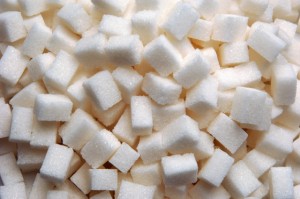 En ny studie visar att ju högre blodsockret är i hjärnan, desto värre är symptomen på Alzheimers sjukdom. Studien visar också att cellerna i hjärnan hos Alzheimerspatienter har svårt att bryta ner och utvinna energi från glukos (blodsocker och hjärnans primära energikälla). Ett högt blodsocker i hjärnan korrelerade dessutom med att personen hade ett högt blodsocker många år innan personen avled. Allt detta är ju saker som stärker tidigare teorier om Alzheimers som en sorts diabetes i hjärnan.
En ny studie visar att ju högre blodsockret är i hjärnan, desto värre är symptomen på Alzheimers sjukdom. Studien visar också att cellerna i hjärnan hos Alzheimerspatienter har svårt att bryta ner och utvinna energi från glukos (blodsocker och hjärnans primära energikälla). Ett högt blodsocker i hjärnan korrelerade dessutom med att personen hade ett högt blodsocker många år innan personen avled. Allt detta är ju saker som stärker tidigare teorier om Alzheimers som en sorts diabetes i hjärnan.
“For the first time, scientists have found a connection between abnormalities in how the brain breaks down glucose and the severity of the signature amyloid plaques and tangles in the brain, as well as the onset of eventual outward symptoms, of Alzheimer’s disease.”
“researchers looked at brain tissue samples at autopsy”
“Researchers measured glucose levels in different brain regions, some vulnerable to Alzheimer’s disease pathology, such as the frontal and temporal cortex, and some that are resistant, like the cerebellum. They analyzed three groups of BLSA participants: those with Alzheimer’s symptoms during life and with confirmed Alzheimer’s disease pathology (beta-amyloid protein plaques and neurofibrillary tangles) in the brain at death; healthy controls; and individuals without symptoms during life but with significant levels of Alzheimer’s pathology found in the brain post-mortem.”
“They found distinct abnormalities in glycolysis, the main process by which the brain breaks down glucose, with evidence linking the severity of the abnormalities to the severity of Alzheimer’s pathology. Lower rates of glycolysis and higher brain glucose levels correlated to more severe plaques and tangles found in the brains of people with the disease. More severe reductions in brain glycolysis were also related to the expression of symptoms of Alzheimer’s disease during life, such as problems with memory.”
“While similarities between diabetes and Alzheimer’s have long been suspected, they have been difficult to evaluate, since insulin is not needed for glucose to enter the brain or to get into neurons. The team tracked the brain’s usage of glucose by measuring ratios of the amino acids serine, glycine and alanine to glucose, allowing them to assess rates of the key steps of glycolysis. They found that the activities of enzymes controlling these key glycolysis steps were lower in Alzheimer’s cases compared to normal brain tissue samples. Furthermore, lower enzyme activity was associated with more severe Alzheimer’s pathology in the brain and the development of symptoms.
Next, they used proteomics – the large-scale measurement of cellular proteins – to tally levels of GLUT3, a glucose transporter protein, in neurons. They found that GLUT3 levels were lower in brains with Alzheimer’s pathology compared to normal brains, and that these levels were also connected to the severity of tangles and plaques. Finally, the team checked blood glucose levels in study participants years before they died, finding that greater increases in blood glucose levels correlated with greater brain glucose levels at death.”
Läs mer om detta via taggen demens och lyssna på avsnittet om Alzheimers där jag har skrivit om detta.
Ann Fernholm refererar också till en mängd tidigare studier på ämnet:
https://www.ncbi.nlm.nih.gov/pubmed/14747300
https://www.ncbi.nlm.nih.gov/pubmed/20713684
https://www.ncbi.nlm.nih.gov/pmc/articles/PMC2769828/
https://www.ncbi.nlm.nih.gov/pubmed/22476197
http://www.neurobiologyofaging.org/article/S0197-4580(13)00435-1/abstract
http://www.fasebj.org/content/early/2014/10/23/fj.14-262048.abstract

Att kalla Alzheimers för diabetes i hjärnan kanske är att ta i, men en dysfunktionell glukosomsättning kan säkert vara en bidragande orsak till många olika sjukdomar i hjärnan beroende på för lite ATP-produktion av mitokondrierna. Vi vet också sedan 1930-talet tack vare nobelpristagaren Otto Warbu.rgs forskning att cancerceller också har det. Frågan är varför man får denna dysfunktionella glukosomsättning? En inte alltför avancerad gissning är för lite fysisk aktivitet i förhållande till intag av socker och andra kolhydrater i kombination med brister på vissa mineraler och vitaminer är grundorsaken. Med andra ord, med mer fysisk aktivitet och intag av näringstäta livsmedel i förhållandet till kalorier så minskar risken betydlig för en rad sjukdomar, inklusive diabetes typ 2.
Vill någon läsa mer om Otto Warburg och cancer så gå in på http://www.halsobygget.se och bläddra bland artiklarna.
Ha en fin helg med mycket fysisk aktivitet ute i det fria ??
/PJ
Det är inte socker som är orsaken.
Det är en infektion som orsakar en inflammation och inflammationen ökar blodsockret.
Sambandet med socker och alzheimers tolkas fel.
Att blodsockret är högre beror på infektionen det är infektionen som orsakar död och högt blodsoker.
http://www.telegraph.co.uk/news/science/science-news/12188092/Alzheimers-disease-could-be-caused-by-herpes-virus-warn-experts.html